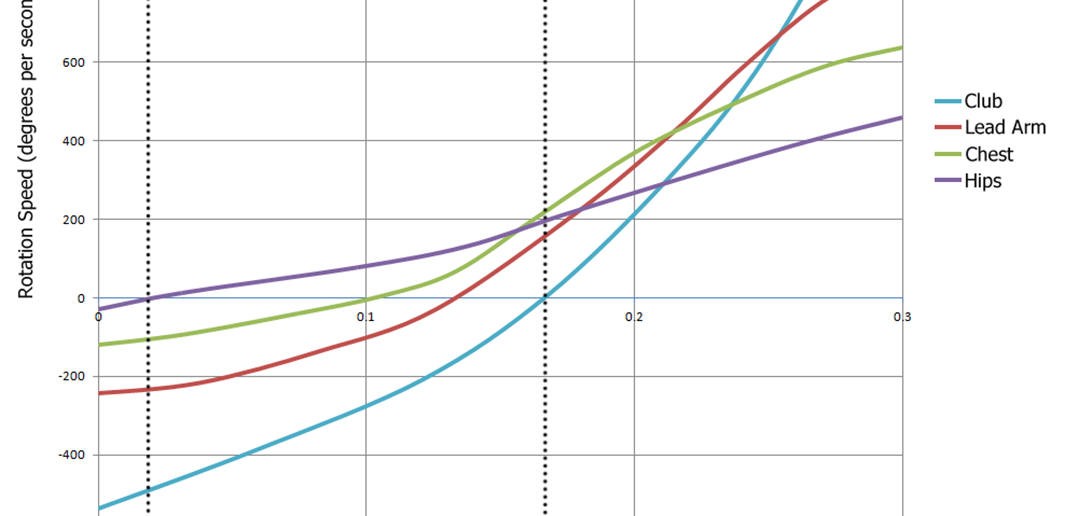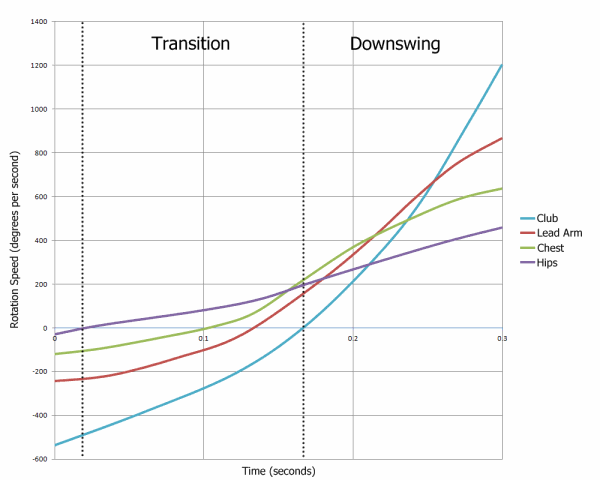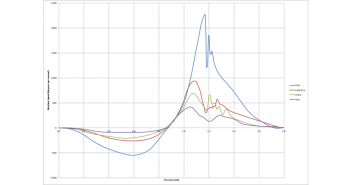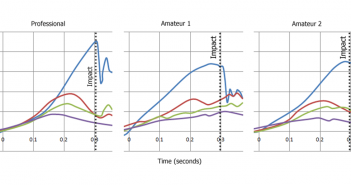The transition is, biomechanically speaking, probably the most important phase of your golf swing. The transition starts when the first segment of your body changes its direction of rotation, and ends when the last segment of your body reverses its motion.
It is the short space of time leading up to what is commonly described as the “top of the backswing” — the point at which the club shaft changes direction. It is the sequence where the golfer transitions from the backswing to the downswing.
The transition phase of a highly skilled golfer only lasts approximately 150 milliseconds (0.15 seconds), but what happens here means everything to your golf swing.
As stated in the previous article, Golf Swing Sequence and Timing, please don’t be put off by all the facts and figures presented here. If you’re not technically minded, then you don’t really need to know this stuff to be a great golfer, but the knowledge presented here will help you to better understand the golf swing, and it may be a very useful tool in helping you to improve.
This section of the site is devoted to the “what” and “why” of a great golf swing transition — what it looks like, what happens and in what order, and why it works that way. The “how” — how to move and how to learn and ingrain a great swing — is presented in the Swing like a Champion system.
Much of what we describe here is discussed in the context of what elite golfers do in their swings, complete with graphs, pictures and videos of their motion. But what any given professional golfer does is not necessarily biomechanically perfect, so we choose real-life examples very carefully.
Unlike other golf tuition, the lessons presented in the Swing like a Champion system are all based strictly on what is biomechanically correct, and not just on what works for other people.
The Transition Kinematic Sequence
A biomechanically efficient transition starts at the bottom and works up, going from the hips (pelvis) to the chest (thorax), the lead arm and finally the club.
In the graph in Figure 1 you can see a close-up of the transition phase of a Tour Pro’s golf swing:
Figure 1. The Transition Kinematic Sequence
The graph in Figure 1 is zoomed in to the transition part of the full swing sequence shown in Golf Swing Sequence and Timing.
The swing progresses in time from left to right. Negative rotational speeds indicate movement away from the target in the backswing. Positive rotational speeds indicate movement toward the target in the downswing.
We can see clearly from the graph in Figure 1 that the hips (purple) change direction first (the line crosses from negative to positive speed), then the chest (green), then the lead arm (red) and finally the club (blue).
The interval between when the purple (hips) curve crosses zero to when the blue (club) line crosses zero is the time from when the hips change direction to when the club changes direction; the transition phase.
The transition sequence shown in Figure 1 is biomechanically correct as far as the order is concerned, that is, a good transition order is hips, chest, lead arm, and then club.
Figure 2. Tiger Woods’ transition.
Note that, for the first half of the transition, the hips (purple) are rotating towards the target while the chest, arms and club are still moving back.
Indeed, we can clearly see (both from the graph in Figure 1 and from the video of Tiger’s transition in Figure 2) that the hips rotate towards the target faster than any other part of your body from the beginning of the transition, until just before the club changes direction.
This rotation of the hips towards the target while the chest is still rotating back, and the fact that the hips keep moving faster than the chest for some time after (until the green curve crosses the purple curve), creates transitional spine stretch — often called “X-Factor Stretch”. The longer the hips (purple) curve stays above the chest (green) curve, the more the spine stretch is increasing, and thus the more power the golfer is able to generate with the large muscles of his core.
This same effect happens to each subsequent body segment in the kinetic chain.
We can see that the chest starts turning back towards the target (the green line goes above zero) half way through the transition, while the lead arm (red line) is still turning back. The chest then keeps turning faster than the lead arm until well into the downswing (the green line stays above the red line). This turn of the chest ahead of the lead arm causes the shoulder to stretch as the shoulder angle closes.
Finally, we see that the lead arm (red line) starts back down while the club (blue line) is still going back, and stays ahead of the club for a long time, well after the club starts back down at the end of the transition. The longer that the arm moves faster than the club, the more that the wrist is stretching and the more club lag that is generated.
Each body segment in the chain lags behind the one inside it. The club lags behind the lead arm, which lags behind the chest, which lags behind the hips.
This lag between segments causes the corresponding muscles and connective tissue around the joint to stretch during the transition period. This helps generate and transfer more energy and speed to the subsequent body segment through the “Stretch-Shorten Cycle”. If the transition sequence is not performed with precise and specific timing, elastic energy from the muscles and joints is lost.
As we have seen, the hips get a good head start. They start back first, well before the chest, and then lead the way throughout the transition. This is important because you need time to stretch the big muscles in your core for maximal power. But our research suggests that the changes of direction of the chest, arm and club should be much more closely, and evenly, spaced, at about 30 milliseconds (0.03 seconds) between each reversal. This is because the muscles between these joints are smaller and so are more efficient when stretched very quickly.
Note that the whole transition happens very quickly, in less than 150 milliseconds (0.15 seconds). The graph in Figure 1 shows a very small amount of time. The transition can’t be rushed, but if it takes too long then the golfer will be loosing the full benefit of the muscle stretches generated during this phase.
There are two mechanisms for transferring momentum along the kinetic chain in the golf swing. The first mechanism is the inter-segmental transfer of energy due to muscle activity, which is augmented through the muscular stretching described above.
The second mechanism, and one of the most crucial in terms of golfers achieving maximum club head speed, is the energy multiplier due to what is called the “compound pendulum effect”. This amazing phenomenon occurs mainly during the downswing, but a smooth, well sequenced transition is crucial for initiating the process successfully. It is described in detail in Golf Lag and the Compound Pendulum.
If you have any questions or comments about this or other articles on Golf Loopy, please send us an email.
Next, see a comparison of the kinematic sequence for typical amateurs and Tour Pros, showing the common flaws that may plague your own golf swing, in Golf Swing Sequence and Timing – Common Faults.
Coming soon: Analysis of the Takeaway and Follow-Through phases.
You May Also Like…
An overview of the golf swing kinematic sequence, including a detailed analysis of the Downswing phase in Golf Swing Sequence and Timing.
Golf Lag and the Compound Pendulum, which describes how you can use physics to generate more speed, accuracy and consistency in your golf swing, with less effort and less strain on your body.
Introduction to the Swing like a Champion System
Overview of a Great Golf Swing, which summarises the correct movements in a great golf swing.
Golf Anatomy and Kinesiology, a collection of articles describing the roles of the muscles involved in the golf swing.
Ground reaction force (GRF), which describes how driving into the ground with your legs transfers power back up through your body.
Kinetic Chain, which describes how the different parts of your body act to transfer energy from the ground to the golf ball.
» The Biomechanics of the Golf Swing.




